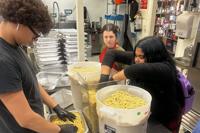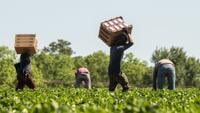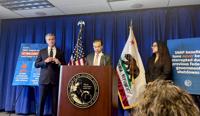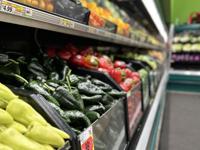
Top Takeaways
- The Trump administration said it would send partial benefits to SNAP recipients, though it did not offer a timeline.
- California schools, families, community organizations and students have been mobilizing to help those affected by delays in SNAP benefits.
- Some K-12 schools are offering students a third daily meal or are setting up pantries for students on campus.
Lilya Medvedev and 84 other students in Kinney High School’s culinary arts program were given a difficult task last Wednesday: plan and prepare 50 healthy meals by Friday for families facing a food crisis due to delays in Supplemental Nutrition Assistance Program benefits.
The students worked into the evening hours and all day Thursday, preparing spaghetti with a marinara sauce chock-full of eggplant, squash, carrots, mushrooms, green peppers and onions.
On Friday, the students and school staff distributed 49 family-sized containers. Most went to the homes of the school’s students, and some went to families at another community school in the Folsom Cordova Unified School District.
“I really enjoyed it. It’s great teamwork, and I’m honored to be able to help other people,” said Medvedev, who is a 17-year-old senior. “People are going through tough times right now.”
California schools, families, community organizations and even students like Medvedev have been mobilizing to help those affected by delays in the Supplemental Nutrition Assistance Program (SNAP), also known as food stamps. They are raising funds, soliciting food donations and coordinating with local food pantries.
“Everyone is scrambling to do as much as possible,” said Adrienne Shilton, senior vice president of public policy and strategy for the California Alliance of Child and Family Services, which represents over 200 community-based organizations that support children, including many that work in schools.
SNAP was originally authorized in 1964 as the “food stamp program.” This is the first time benefits have been delayed. The Trump administration planned to freeze all SNAP funds on Nov. 1, but on Friday, two federal judges ordered the administration to tap into contingency funds. The administration said Monday it would send partial benefits to SNAP recipients, though it did not offer details on when or how much aid recipients will see, according to the Associated Press.
Nearly 2 million children statewide rely on SNAP funds, known in California as CalFresh, for their meals. All K-12 students receive free breakfast and lunch on school days through California’s Universal Meals Program, but that’s not enough for families who rely on those benefits.
Shania Shatswell relies on CalFresh to feed her five children. Three attend Jefferson Elementary School in Bakersfield, where they receive breakfast and lunch, but she worries about her two younger ones still at home. Typically, her EBT card is reloaded on the 6th of the month, but she is preparing for indefinite delays.
“Right now I’m just hitting every food bank possible,” Shatswell said. “It’s scary not knowing if you can feed your kids at the end of the day.”
Community groups step up
The response to the delay in SNAP benefits was a reminder of the early days of the pandemic, according to Shilton. There have been a lot of “flash fundraisers” and coordination to make sure SNAP recipients are able to take advantage of food pantries or emergency funds.
“There’s been a lot of resource sharing among members,” she said.
Some local governments, such as San Francisco, are offering grocery cards to CalFresh recipients for the month of November. But organizations serving school communities have also stepped up.
The Oakland Public Education Fund launched a fundraising campaign to help stock school food pantries and pay for families’ groceries. The organization is a nonprofit that raises funds and organizes volunteers for all schools in the district, where 74% of students are from low-income families.
“Luckily, all of our kids can get two meals a day at school, but what happens on the weekends and what happens at dinner?” said Ali Medina, the organization’s CEO. “Food insecurity already existed. This is exacerbating it.”
Medina said the fundraising campaign is modeled after one the group organized during the Covid-19 pandemic that raised about $1.5 million for cash assistance and groceries for families. As of Monday morning, the organization had raised more than $15,000. She said the organization will work with the school district staff to distribute the funds to schools and families that need them most.
“We’re not quite sure the scale of how bad this is going to get, and for us, it’s really important that there be a rapid response,” Medina said. “We know that California is going to step up, our city and county governments are going to step in, but in the meantime, we’re getting some funds immediately out the door.”
Community schools play a unique role
Community schools, which act as a neighborhood hub with wraparound services for families, are working rapidly to address the SNAP crisis.
Ayer Elementary, one of the 29 community schools in Fresno Unified, where nearly 9 out of 10 students come from families considered socioeconomically disadvantaged, regularly hosts a four-hour food distribution event each month, typically serving around 150 families from Ayer and neighboring schools.
At the monthly event on Friday — a day before November SNAP benefits began to lapse — 500 individuals flooded the food distribution. The school was only able to serve half of those families before running out of food, said Sal Lucatero, the community school coordinator for Ayer.
“We saw an increased need,” he said. “This time, we noticed that there were families coming from other schools that were not community schools, from other regions and even from outside of our district trying to get food.”
As a result, the school is planning emergency food distribution pop-ups this week for families identified by the district.
“At the end of the day, we are still just schools,” Lucatero said. “Although we are community schools, our intention is to be a resource hub and a source of support for our families. We are not a food pantry. We are a school operating as an emergency food, food distribution center, pantry.”
School districts respond
Many school districts are working with local community organizations and pantries to ensure that families can find the food that they need.
In addition to the meals made by Kinney High School students, Folsom Cordova Unified School District leaders have asked each school to start an emergency food bank to support families, students and staff impacted by the disruption of food benefits, said Angela Griffin Ankhelyi, chief communications officer for the district.
Some school districts are ensuring that students have access to a third meal at school during the week.
In San Francisco, the district announced Friday that due to the SNAP cuts, the district is expanding its Supper Program to offer an afternoon meal to any child or young person who was 18 or younger at the beginning of the school year, even if they are not enrolled in the district.
The Los Angeles Unified School District — home to roughly 217,000 students who receive SNAP benefits — already provides breakfast, lunch and dinner to kids who need it.
Now, the district is ramping up its efforts, adding dinner pick-up options at most campuses for all children — even those who are not students — under the age of 18.
Schools in the San Luis Coastal Unified School District in San Luis Obispo County offer a “share table” where students can contribute anything they don’t plan to eat.
Erin Primer, the district’s director of food and nutrition services, said they have seen an increase in the number of students taking advantage of the shared space.
Educators see the impact of poverty and hunger in their classrooms, according to a statement from United Teachers Los Angeles, which called SNAP benefits a “lifeline.” The union has also called upon Gov. Gavin Newsom and local leaders, including Los Angeles Unified School District Superintendent Alberto Carvalho, to declare a state of emergency.
Those Kinney High meals were so popular that the school plans to do it every Friday this month.
“We’re just trying to make our families feel welcome and part of the community because we know that it’s tough,” said Principal Allen Sims. “We don’t want them to be alone, and we want them to know that we care about them.”













(0) comments
Welcome to the discussion.
Log In
Keep it Clean. Please avoid obscene, vulgar, lewd, racist or sexually-oriented language.
PLEASE TURN OFF YOUR CAPS LOCK.
Don't Threaten. Threats of harming another person will not be tolerated.
Be Truthful. Don't knowingly lie about anyone or anything.
Be Nice. No racism, sexism or any sort of -ism that is degrading to another person.
Be Proactive. Use the 'Report' link on each comment to let us know of abusive posts.
Share with Us. We'd love to hear eyewitness accounts, the history behind an article.